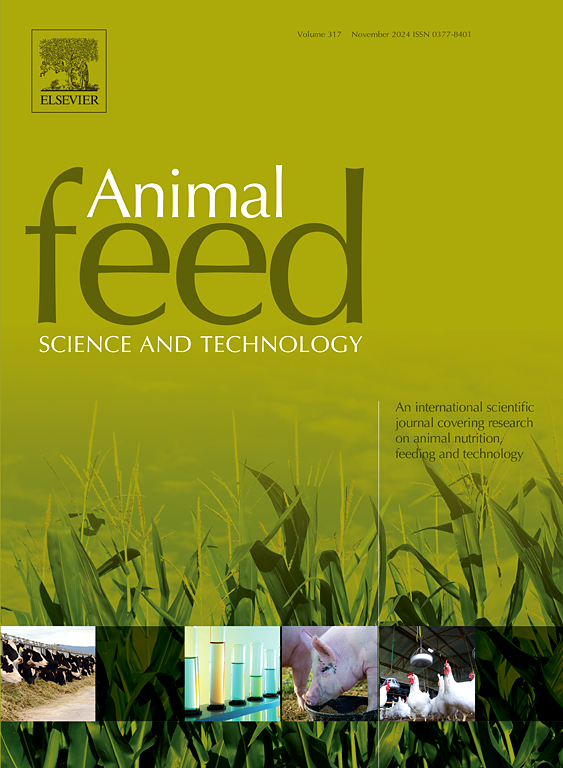具有产生外植体糖特性的植物乳杆菌 L75 的心理营养作用对低温条件下燕麦青贮饲料的发酵、细菌群落和抗氧化活性的影响
IF 2.5
2区 农林科学
Q1 AGRICULTURE, DAIRY & ANIMAL SCIENCE
引用次数: 0
摘要
青藏高原燕麦收获季节的低温是成功青贮发酵的主要挑战。本研究旨在探讨具有产外源糖(EPS)特性的植物乳杆菌(L. plantarum)L75精神营养型菌株对低温青贮燕麦发酵质量、细菌群落和抗氧化活性的影响。新鲜切碎的燕麦经过三种不同的处理:ⅰ)不接种(对照);ⅱ)接种具有产 EPS 特性的精神营养型 L. plantarum L75;ⅲ)接种商业接种剂 L. plantarum。所有接种剂的施用量均为 1 × 105 cfu/g(按新鲜物质计算),然后分别在 25、15 和 10℃下进行腌制。结果表明,在低温条件下,与商业接种剂相比,菌株 L75 在 EPS 产量、生长速度和产酸量方面表现更佳。与对照青贮饲料相比,接种这两种菌株可提高发酵质量,并在整个发酵过程中抑制Hafnia alvei和Ewingella americana等不良微生物,从而改善燕麦饲草的青贮质量。重要的是,在提高发酵质量、抗氧化活性和植物乳杆菌比例方面,L75 比商业接种剂更有效,从而降低了燕麦青贮饲料在低温条件下的干物质损失。总之,具有产EPS特性的精神营养菌株L75在低温条件下通过改变细菌组成来改善燕麦青贮饲料的发酵质量和抗氧化活性方面具有很大的潜力。因此,菌株 L75 可作为一种候选菌株,用于在牧草收获季节低温的高寒地区制作优质青贮饲料。本文章由计算机程序翻译,如有差异,请以英文原文为准。
Effect of psychrotrophic Lactiplantibacillus plantarum L75 with exoploysaccharides-producing property on fermentation, bacterial community, and antioxidant activity of oat silage at low temperature
The low temperature during oat harvesting season in the Qinghai-Tibet Plateau (QTP) is a primary challenge for successful silage fermentation. This study aimed to investigate the effect of a psychrotrophic Lactiplantibacillus plantarum (L. plantarum) L75 strain with exoploysaccharides (EPS)-producing property on fermentation quality, bacterial community, and antioxidant activity of oat silage ensiled at low temperature. The freshly chopped oat was subjected to three different treatments: ⅰ) no inoculation (control); ⅱ) inoculated with psychrotrophic L. plantarum L75, possessing EPS-producing properties; ⅲ) inoculated with a commercial inoculant L. plantarum. All inoculants were applied at a rate of 1 × 105 cfu/g on a fresh matter basis, and then ensiled at 25, 15, and 10℃, respectively. Results indicated that the strain L75 exhibited better performance in EPS production, growth rate, and acid production compared to the commercial inoculant at low temperature. Inoculating with both strains improved the silage quality of oat forage by enhancing fermentation quality and suppressing undesirable microorganisms such as Hafnia alvei and Ewingella americana throughout the fermentation process compared to the control silage. Importantly, L75 was more effective than the commercial inoculant in enhancing fermentation quality, antioxidant activity, and the proportion of Lactiplantibacillus plantarum, leading to lower dry matter loss of oat silages at low temperature. In conclusion, the psychrotrophic strain L75 with EPS-producing property has great potential to improve fermentation quality and antioxidant activities of oat silage by altering bacterial composition at low temperatures. Thus, strain L75 can be used as a candidate strain for making high-quality silage in alpine region with low temperature in forage harvesting season.
求助全文
通过发布文献求助,成功后即可免费获取论文全文。
去求助
来源期刊

Animal Feed Science and Technology
农林科学-奶制品与动物科学
CiteScore
6.00
自引率
6.20%
发文量
266
审稿时长
3 months
期刊介绍:
Animal Feed Science and Technology is a unique journal publishing scientific papers of international interest focusing on animal feeds and their feeding.
Papers describing research on feed for ruminants and non-ruminants, including poultry, horses, companion animals and aquatic animals, are welcome.
The journal covers the following areas:
Nutritive value of feeds (e.g., assessment, improvement)
Methods of conserving and processing feeds that affect their nutritional value
Agronomic and climatic factors influencing the nutritive value of feeds
Utilization of feeds and the improvement of such
Metabolic, production, reproduction and health responses, as well as potential environmental impacts, of diet inputs and feed technologies (e.g., feeds, feed additives, feed components, mycotoxins)
Mathematical models relating directly to animal-feed interactions
Analytical and experimental methods for feed evaluation
Environmental impacts of feed technologies in animal production.
 求助内容:
求助内容: 应助结果提醒方式:
应助结果提醒方式:


